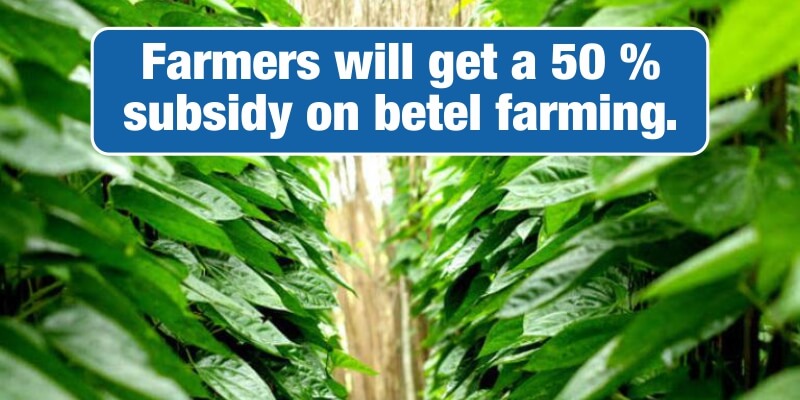How to cultivate betel and how much subsidy you will get, know full information: Grants are given by the central government to the farmers for the cultivation of many types of crops.
KhetiGaadi always provides right tractor information
For this, many schemes are being run by the government. But due to a lack of information about these schemes, farmers are not able to take advantage of them.
From time to time, through Tractor Junction, we keep giving information about various schemes being run by the government to the farmers so that the farmer brother can take advantage of these schemes.
In this sequence, today we are giving you information about the subsidy given by the government on the cultivation of betel leaves.
Explain that the benefit of subsidy is provided by the government to the farmers cultivating betel leaves. For this, a scheme named Rashtriya Krishi Vikas Yojana-Raftaar has been operated by the government.
Under this, farmers are provided the benefit of a subsidy of up to 50 percent on betel cultivation.
The purpose of the government behind giving subsidies on betel cultivation is to encourage farmers to increase the production of betel leaves in the country.
Uttar Pradesh and Madhya Pradesh are getting the benefit of the scheme: Recently, in response to the question asked by Kunwar Pushpendra Singh Chandel in the Lok Sabha, Union Agriculture Minister Narendra Singh Tomar said that the government gives grants to the farmers cultivating betel in selected areas of Uttar Pradesh and Madhya Pradesh under Rashtriya Krishi Vikas Yojana-Raftaar.
In the Lok Sabha, Kunwar Pushpendra Singh Chandel asked whether the government has made special efforts to promote the cultivation of betel leaves on a cooperative basis in Bundelkhand, In its written reply, the Union Agriculture Minister informed about the efforts being made by the government for betel production.
How much subsidy is available on betel cultivation: The Union Agriculture Minister said in his reply that the Central Government is promoting betel cultivation in the country under the Rashtriya Krishi Vikas Yojana-Raftaar.
Under the scheme, the government of Uttar Pradesh and Madhya Pradesh is providing 50 percent assistance for the setting up barrows (pandals) in clusters for betel cultivation with a grant of Rs.50453 for a maximum of 1000 square meters.
A total of 104 hectares have been covered under this program in the state of Uttar Pradesh during the period from 2018-19 to 2021-22. In Madhya Pradesh, in 2015-16, an area of 44.4 hectares was covered under this scheme.
Nucleus helps to produce planting material: He said that the Directorate of Areca and Spices Development, Calicut, under the Ministry of Agriculture and Farmers Welfare, would provide assistance to State Agricultural Universities and Agricultural Research Councils through Integrated Horticulture Development Mission to produce good quality nucleus planting material of betel leaves. Is performed.
Two hi-tech planting material production structures, one at Regional Research Station Beltal, Mahoba district with the financial assistance of 11.2 lakhs, and the other at Krishi Vigyan Kendra, Lalitpur district with the financial assistance of 15.6 lakhs (under Banda University of Agriculture and Technology) betel farmers established to meet the requirements of planting material.
Where is the cultivation of betel in India (Pan Ki Kheti): In India, betel is cultivated on about 50,000 hectares. States, where betel is cultivated, include Karnataka, Tamil Nadu, Orissa, Kerala, Bihar, West Bengal, Assam (Northeast states), Andhra Pradesh, Maharashtra, Uttar Pradesh, Madhya Pradesh, Gujarat, Rajasthan.
How to do betel cultivation/method of betel cultivation: Traction activities for betel cultivation in North India start after 15th January.
For good betel cultivation, deep plowing of the land is done and the land is left open. After that two shallow plowings are done, then Bareja is made. This process is completed by February 15-20.
In the prepared barges, from the last week of February to March 20, betel vines are transplanted in the form of double betel vines by row method.
For good cultivation of betel, it is necessary to keep a proper distance from row to row. For this, the row-to-row distance is 30 by 30 cm. Or 45 by 45 cm. is kept. Central part cuttings are taken from betel vine as seed planting, which is ideal cutting for planting.
For good germination and growth in betel vine, cover the betel cuttings with grass by mulching them well and sprinkling water three times. Since the temperature rises very rapidly from March onwards.
Therefore, moisture is created by giving water to protect the plants, so that the moisture remains in the barges.
Along with the vines, he also cultivates flax for good propagation of betel vine, which provides shade and protection to the betel vines as needed.
medicinal properties of betel leaves:
Many types of medicinal properties are found in betel leaves. Betel leaves are used in many types of diseases. Some of the medicinal properties of betel leaves are as follows-
Betel removes sore throat and itchiness.
It removes bad breath and enhances digestion power.
At the same time, the paste of its crushed fresh leaves prevents the rotting of cuts and wounds.
For indigestion and anorexia, using betel leaves with black pepper before eating in the morning ends the problem of indigestion and anorexia.
To remove dry phlegm, use betel leaves with salt and carom seeds in the mouth before sleeping, and using is beneficial.
If there is a blister in the mouth, putting licorice powder in betel leaf provides relief.
From where can I get training in betel cultivation: Mahoba district of Uttar Pradesh is famous for betel cultivation.
In order to promote betel cultivation, in the year 1980-81, the only betel and training center was established in the Mahoba district, whose main objective was to conduct experiments on betel cultivation, selection of suitable species, and management of insect diseases.
The recommendations received from them are to be made known to betel farmers and to provide training on various aspects related to betel cultivation.
Apart from this, economic and technical information has to be provided to the betel-producing farmers to promote betel production in the state.
Training programs are organized by the institute from time to time. Farmers can get training in betel cultivation by participating in these programs.
To know more about tractor price contact to our executive







I need government subsidy for betel plantation
Help full for me